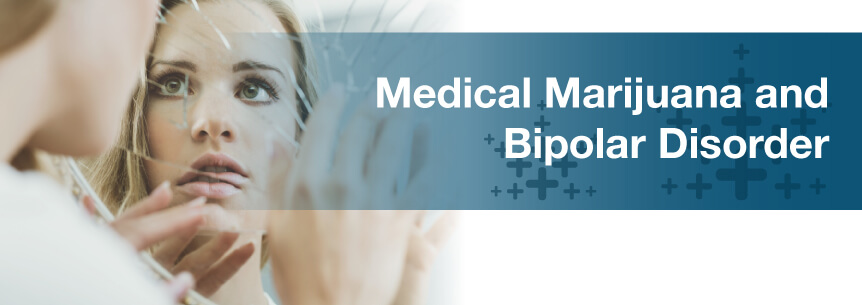
From multiple sclerosis to depression to cancer, medical marijuana is helping people deal with an array of health conditions and their treatment. Now bipolar disorder patients can turn to medical marijuana for addressing their bipolar disorder, too.
Some research has linked cannabis use with a psychotic threshold decrease where you transition into active psychotic symptoms. Your symptoms may get worse. However, cannabis use can lower the age where you start experiencing bipolar disorder symptoms.
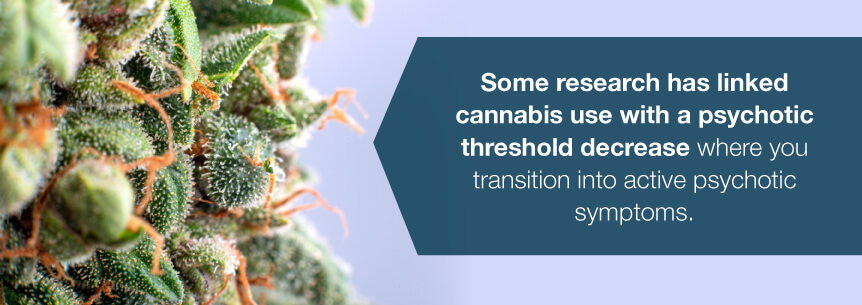
But, the relationship between bipolar disorder and marijuana is up for debate since some studies have shown cannabinoids may provide therapeutic applications in bipolar disorder and anecdotal evidence supporting this claim.
Find A Doctor Find A Dispensary
Research has shown some mood disorders, such as Bipolar Disorder, can run in families, with the potential to skip a generation of diagnosed cases. Beyond the known causes of chemical imbalances in the brain and the chemical transmitters not working properly between the cells of the brain, it isn’t certain why some people are predisposed to bipolar disorder, and others are not. Bipolar refers to the two poles of mood, similar to a battery. One is for the “positive” effects of mood and the other “negative.”
Usually, the person with bipolar disorder has rapid swings in mood, cycling from high energy and inflated sense of self and even elation to severe depression and exhaustion leaving them unwilling to crawl out of bed on any given day. The more rapid the cycle, the more dangerous the situations for the patient with bipolar disorder as both extremes can result in death from suicides, accidents or carelessness because they think they can fly, run faster than a train, etc.
These mood cycles over the last fifty years were controlled with some powerful drugs and even treated with electroshock therapy. “One Flew Over The Cuckoo’s Nest” is all about mood disorders and bipolar treatments. Half the characters in the story suffer from a mood disorder. These barbaric treatments leaving patients overmedicated and over-treated led the revolution to find “safer” drugs to treat these disorders.
In the last thirty years, lithium, the very dangerous substance used to charge batteries, became available in pill form to treat bipolar disorder. Its promising effects kept it on the market, and it’s still in use today despite the fact studies have revealed the long-term use of lithium damages the speech and thought processes of the brain. Patients who regularly take lithium have to have regular blood draws to check for toxic levels of the drug in their livers/systems.
Researchers engaged in a literature review of marijuana for bipolar disorder in one study and of cannabinoids neuropharmacological properties and found some patients with bipolar disorder use cannabis to ease their depression and mania symptoms. This suggests marijuana may have potential therapeutic effects in bipolar disorder.
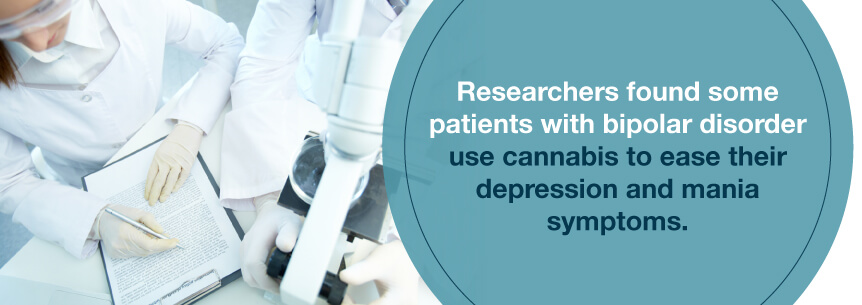
You may use nabilone and dronabinol, pure synthetic cannabinoids, and specific plant extracts containing CBD, THC or both in known concentrations sublingually. We’ve now seen controlled trials of the two cannabinoids as a secondary medicine in bipolar disorder.
Bipolar can bring on a whole range of symptoms medical cannabis can treat, such as:
But these patients don’t have to start lithium, ever. The two main strains of medical marijuana, indica, and sativa, can be used together or separately to treat the symptoms as the patient starts to cycle.
Indica is often used to calm, alleviate anxiety, and relieve insomnia, which could be used when the patient is experiencing a high cycle and can’t be bothered to come down to sleep, eat, or focus. Sativa elevates mood and acts as a stimulant. It’s most effective for the lows in the person with bipolar disorder. So much relief could be gained and without any harm to the body’s organs or long-term damage to the brain and liver through the use of medical marijuana.
So why aren’t more people with mood disorders like bipolar disorder being treated with medical marijuana? It’s simple really. Either they don’t live in a state legalized its use (like Wisconsin, where depression is rampant due to less sun all year round) or lack of information and informed choice in the states where it is legal.
MarijuanaDoctors.com makes it a point of our website to get the word out on the benefits medical marijuana has for so many people. We can and will help anyone find a qualified doctor in the right state get the prescription they need for medical marijuana control in a more natural and healthy way their bipolar or mood disorder. That’s a guarantee.
There is anecdotal evidence supporting the promise medical cannabis for bipolar disorder can help you manage your depressive or manic episode symptoms with the right treatment plan. According to one man, his wife functions better after marijuana and bipolar disorder treatment. It helps her sleep, relaxes her when she’s hypomanic and slows down her speech. Medical cannabis keeps her more active when she would otherwise lie in bed in a depressive state. While lithium also helps, it isn’t always effective keeping her in control.
None of the studies conducted considered strain or dosage type, and these are two essential factors to consider when studying cannabis. With so many different types of strains available, bipolar patients have many possibilities to find relief.
Depending on what type of marijuana is used, studies may misrepresent consistency. For example, patients with bipolar disorder who smoke high THC marijuana concentrates may be more likely to have a negative mood response whereas those who smoke strains rich in CBD directly from the cannabis flower may find more positive mood responses.
Indica strains reduce anxiety and have a calming effect. Sativa strains stimulate and elevate the mood. And doctors may prescribe cannabis and bipolar disorder treatment as part of your overall treatment strategy for your BP. Some good strains to try include:
The stereotypical assumption with medical weed is you have to smoke it. But there are various other interesting ways to use this herb. Trying a different consumption method comes with various practical benefits, too, such as increasing discretion. However, it may also change the effect you get, such as the intensity or duration of a high and other effects. Here are some consumption methods you may want to try:
While there are still questions about whether individuals should treat their bipolar disorder with medical cannabis, only you will know if this medicine will help relieve your symptoms. Browse for a medical marijuana dispensary or search for a cannabis-certified doctor so you can sit down and discuss this potent herb’s potential in treating your depressive or manic episodes.
Find A Doctor Find A Dispensary
Bipolar disorder, previously referred to as manic depression, is a mental health disorder characterized by extreme mood swings alternating between lows — depression — to highs — mania or hypomania.
With depression, you may feel hopeless or sad and lose pleasure or interest in most activities. When your mood shifts into hypomania or mania, you might feel full of energy, euphoric or unusually irritable. These various mood swings can affect your activity, behavior, sleep, judgment, and ability to think clearly.
Mood swing episodes may come on multiple times a year or rarely. Between occurrences, some individuals may experience emotional symptoms, while others might not experience any.
Even though bipolar disorder usually afflicts you for life, a treatment plan can help manage its symptoms and mood swings. Typically, doctors treat the condition with psychotherapy, or psychological counseling, and medication.
Various bipolar disorder types exist, but all involve episodes of mania and depression to a certain degree. These forms consist of these five:
In the first century in Greece, Aretaeus of Cappadocia started recording bipolar disorder symptoms in the medical field. For many centuries, his association between depression and mania went unnoticed.
The ancient Romans and Greeks generated the terms “melancholia” and “mania,” which today mean depressive and manic. Even back then, they realized lithium bath salts helped to calm manic individuals down and lift the spirits of individuals who were depressed. Lithium today continues to be a common treatment for patients with bipolar disorder.
Bipolar disorder patients experience alterations in how they sleep, unusually intense emotion, strange behaviors and changes in their activity levels. These individual episodes are known as “mood episodes.” Individuals with bipolar disorder mood episodes behave much differently than the typical behaviors and moods of an individual. Extreme changes in sleep, energy and activity go hand-in-hand with mood episodes.
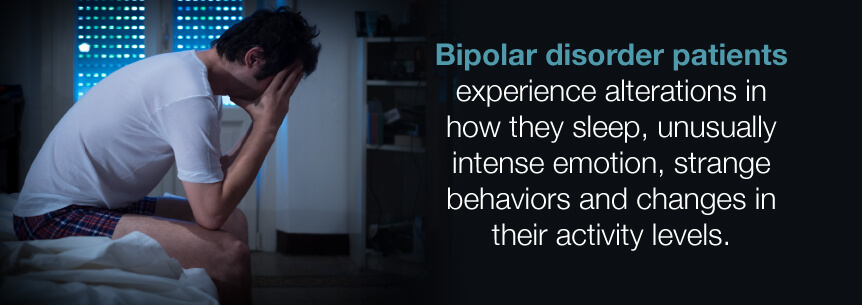
In some cases, a mood episode will include symptoms of both depressive and manic symptoms, characteristic of mixed features. When you’re experiencing mixed features, you may feel empty, sad or hopeless, but still feel incredibly energized.
The longer your bipolar disorder goes untreated, the worse it tends to get. Diagnosis and treatment delays often result in social, personal and financial problems, making your disorder more troubling to handle for both you and those around you.
Treatment, however, can help those dealing with this life-long illness manage their symptoms and live a normal life.
Statistics reported by the Depression and Bipolar Support Alliance reveal:
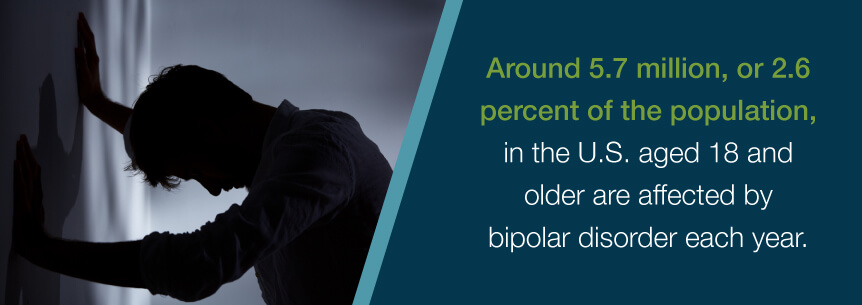
Most bipolar patients, even people who have severe forms of the condition, can substantially stabilize their symptoms and mood swings with the right treatment. Since this is a recurrent illness, professionals highly encourage long-term preventative treatment. For optimal management of the disorder long-term, you’ll need a treatment plan of both psychotherapy and medication.
Typically, you would begin balancing your mood swings immediately with medication. You can experience side effects with these drugs, depending on the medicine you’re prescribed.
To relieve these types of symptoms, your doctor may try a different medication or change your dose. You should never change or stop a medication without the guidance of your doctor.
If your bipolar disorder has led you to abuse drugs or alcohol, you may need substance abuse treatment. Otherwise, you may have a hard time managing your condition.
While getting your symptoms under control, your physician or psychiatrist may suggest a day treatment program where you can get counseling and support.
If you feel suicidal, are behaving dangerously or are becoming psychotic, or detached from reality, your physician may recommend hospitalization. While at the hospital, you’ll receive psychiatric treatment designed to keep you safe and calm while treatment stabilizes your mood, regardless of if you have a major depressive or manic episode.
As mentioned, bipolar disorder is a lifelong disorder, and treatment for it is as well, even if you’re experiencing times where you’re feeling better. If you skip treatment, you have a significant risk of symptom relapse or having your mild mood changes turn into full-blown depression or mania.
The main bipolar disorder treatments include psychological counseling, or psychotherapy, and medication to control your symptoms. You’ll also have access to support groups and education.